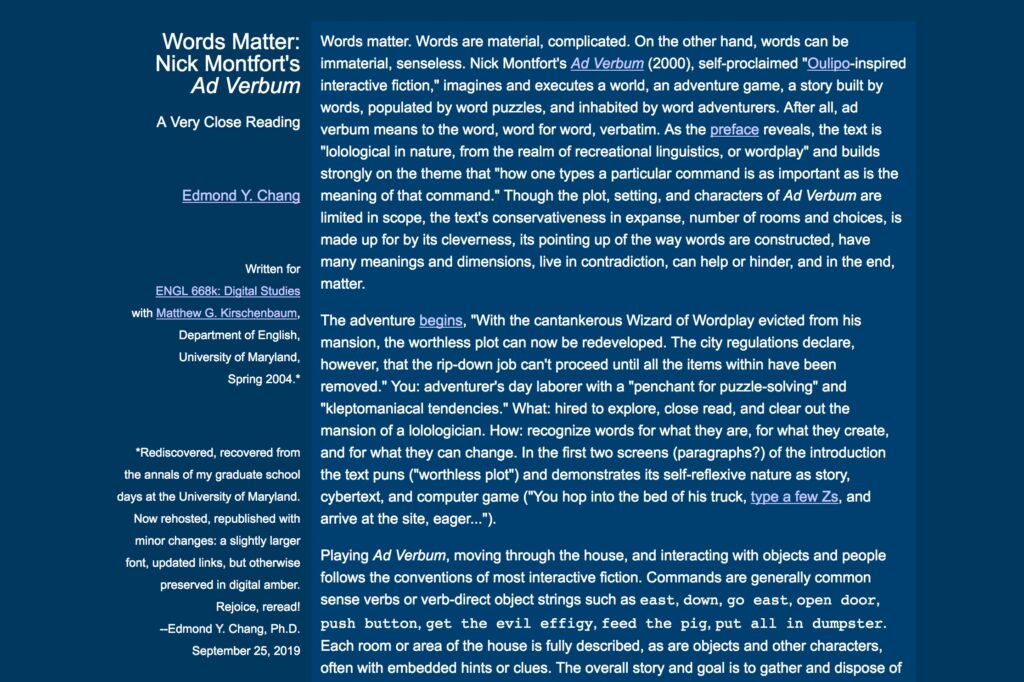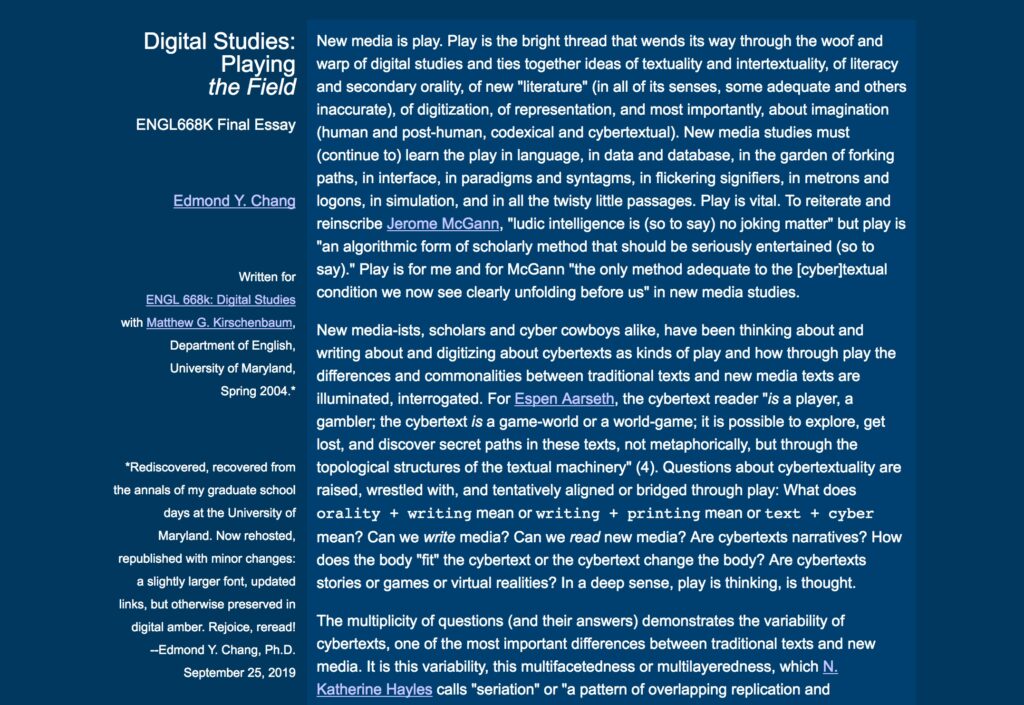One of my courses this autumn semester is an Honors Tutorial called “Electronic Literature, Digital Narratives” (ENG 3970T). The course description reads:
N. KATHERINE HAYLES asks at the start of “Electronic Literature: What Is It?” the following: “Is electronic literature really literature at all? Will the dissemination mechanisms of the Internet and World Wide Web, by opening publication to everyone, result in a flood of worthless drivel? Is literary quality possible in digital media, or is electronic literature demonstrably inferior to the print canon? What large-scale social and cultural changes are bound up with the spread of digital culture, and what do they portend for the future of writing?” This class will only begin to answer these questions, but more importantly, it will explore the intersections of writing, literature, genre, digital media, video games, and popular culture. We will read, experience, and play a range of traditional and “born digital” texts to consider how they mediate narrative, worldbuilding, identities, and bodies. Texts may include Jorge Luis Borges, Espen Aarseth, Shelley Jackson, Vannevar Bush, Michael Joyce, Nick Montfort, Marie-Laure Ryan, Anna Anthropy, Porpentine, and others.
Over the course the term, my tutorial student and I will survey a number of “interactive” and “ergodic” texts from Choose Your Own Adventure books to hypertext fiction to text games to social media stories to video games. This current week, Week 5, we read and played two “classic” interactive fiction texts: Andrew Plotkin’s Shade (2000) and Nick Montfort’s Ad Verbum (2000). Both are excellent exemplars of the genre (the first is more “novelistic,” as Montfort would argue, and the latter is more “riddle machine”) and are quite entertaining and illuminating. As we discussed each, I mentioned to my student that I had first played both in graduate school while at the University of Maryland (where I earned my MA). In fact, I said, I wrote a paper about Ad Verbum, which was now buried somewhere in the archives and ruins of a lifetime ago; I said I would try to find it for them to read.
In a twisty little passage of fate, during our tutorial session today, when we loaded up Ad Verbum to play a little during our discussion, I noticed a line on the page that I somehow totally missed before:
“There’s a paper about Ad Verbum. (Link thanks to the Internet Archive.)”
From: https://nickm.com/if/adverbum.html
I clicked on it, and lo and behold, it was a link to my essay! Snapshotted by the Internet Archive circa 2004. I could not believe my eyes. Who knows how long that has been there, just waiting for someone to click it and read it. Ironically, because Montfort’s site does not attribute the essay directly to me, it would never have been spidered over by search engines, meaning I would not have found it in my periodic checks for citations. (Ah, the tribulations of building a tenure file!)
I told my student that I would resurrect the essay for them to read. The essay was written for a seminar on digital studies led by Dr. Matthew G. Kirschenbaum. It was originally hosted on my website long before I switched to WordPress. Here it is with a little marginal note that reads:
“Rediscovered, recovered from the annals of my graduate school days at the University of Maryland. Now rehosted, republished with minor changes: a slightly larger font, updated links, but otherwise preserved in digital amber. Rejoice, reread!”

You can read “Words Matter: Nick Montfort’s Ad Verbum” here: http://www.edmondchang.com/wordsmatter/
I also discovered alongside the above essay a final essay written for the course. I do not remember the prompt (I am sure I could find it somewhere in my paper files) but it seems to be a “state of the field” or “survey of main ideas” type essay. Here is that bit of writing:

You can read “Digital Studies: Playing the Field” here: http://www.edmondchang.com/digitalplay/
What a lovely walk down memory lane! Unearthing these little semi-precious gems made a little nostalgic for my graduate school days. I remember enjoying writing them and putting them in web format. A note to readers: be kind, that was so long ago, and I was new to it all!